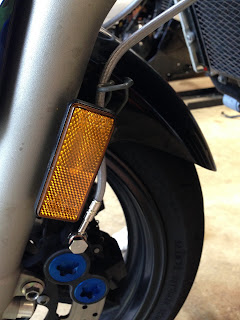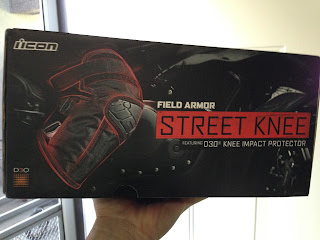Getting a bit more 'whoa' from the FZ's 'go'.
The Yamaha FZ1has never been short on power. A quick twist of the wrist and you'll be going from normal to nuts in short order. With that big 1000cc inline four cylinder and the gearing set-up the bike has, there is very little engine braking in the upper gears. The Yamaha Blue Dot calipers do a decent job of slowing the bike down from street legal speeds, but quick, hard braking into a corner leaves a little to be desired. Unlike the old V-Strom, upgrading to a bigger, more powerful caliper isn't an easy job. Most serious FZ1 owners actually swap over to a Yamaha R1 front fork set-up in order to get bigger, upside down forks and better brakes at the same time. One of the easiest methods of getting some better stopping power is to switch over to stainless steel braided lines. That is what I was able to do this week. Follow along as I go through the process.
I got my lines from Galfer as can be seen in the box from Revzilla. Ordering them from Revzilla got me a couple of bucks off the Galfer website retail price. Galfer is a local company to me here in Oxnard, CA. I followed the tracking progress of the shipment and I'm pretty sure the lines went from Oxnard to Revzilla's warehouse in Pennsylvania and back again to Oxnard then to my door. Such is the modern way of things with online ordering and instant tracking. It makes sense to someone. I got a front and rear set of lines. Galfer always includes the hardware and even extra banjo bolt washers in their packs. I have Galfer's on the Ninja race bike and are the lines I put on the V-Strom.
First I started with the rear brakes. I had forgotten my keys at home when I went to work this last Wednesday. I couldn't unlock my office and of course I locked myself out of the house for good measure. The good wife was running the older kid to school so I knew I had a little bit of time to play in the garage before she got back home and could get my keys. The rear end seemed a good place to get going in the limited time I had. Here I un-bolted the rear master cylinder and drained the old fluid from it.
I used an old syringe from some medical device related to having children in the house. The cup is also from some medical supplies. I'll give you a hint, it is for taking a sample to the lab. Anyway, the fluid looked really fresh. I'd have to check my service sheet from the purchase of the FZ, but I think they changed the brake fluid while prepping the bike for the sale. I sucked the fluid from the master cylinder and deposited it into the cup for disposal later. With brake fluid it is recommended that you change it out every couple of years to maximize braking performance. More so if you are racing and doing lots of hard braking. I was happy to see fresh looking fluid in both the front and rear master cylinders.
I broke the line free at the master cylinder and at the caliper. I placed the cup under the caliper banjo bolt and let it drain out. From there I weaved the old line out from the clips that hold it to the swing arm and brake torque arm. I tried to keep the area clean with plenty of rags and I even used rubber gloves. Brake fluid is nasty stuff and I didn't want it to get all over my uniform, my tires or on the bike's paint.
All of that only took about fifteen minutes total. I had to stop here as the wife got home so I was able to get ,y keys and go to work. I buttoned up the master cylinder and caliper by placing the banjo bolts in their respective holes. That way I could keep crap from getting into the system while I earn a paycheck. I wasn't able to finish the brakes that day so it was a couple of days before I could get back to the installation.
And here is the final result. The new silver stainless line looks good on the bike. The upward bend in the line gave me some trouble in getting a proper bleeding as the caliper bleeder is at the very bottom of the rear brake system. Adding in the reassembly time, the rear end only took about 40 minutes to get done, including an initial bleed. Not bad as far as time goes. Tool wise I only needed the fluid drain materials and three metric wrenches. This is really a simple job to start with for a new bike mechanic bikes. If you are new to this, get someone to check your work. Getting a brake job wrong can have disastrous consequences as you might imagine.
Moving onto the front end later in the week, I drained the front master cylinder the same way and dove into removing the front brake line set-up. Here you can see the crossover piece that splits the single hose from the front master cylinder into two sides, one for each of the front calipers. You can also see the bikes horn hanging down behind the line on the right side of the picture. The front brake line crossover and horn share a mounting location on the lower triple tree of the forks. I had to get the horn out of the way to remove a bracket and the crossover piece.
Another 20 minutes later and the old front lines were off the bike. While the stock rubber lines looked to be in great condition, they are almost 14 years old so it was definitely time for replacement. In this picture you can see the single line that comes from the front master cylinder and splits into two using the crossover piece. Most OEM brakes are like this. It must be cheaper to manufacture than two separate lines. Most stainless brake line companies replace this type of set-up with two individual lines that use a dual banjo bolt at the master cylinder and two individual lines from the master cylinder to each caliper.
Here is the upper end by the master cylinder with the new lines installed. They look awesome and very mechanical. I had to play around with the placement to get them to line up going down the fork since the new lines are doubled up at the master cylinder as mentioned previously. The new lines were different lengths, the longer of the two goes to the left side caliper since the front brake master cylinder is on the right side of the handlebar. When bleeding the brakes after changing the fluid or a new line install such as this, I always bleed the lines by cracking the banjo bolt seen here where it screws into the master cylinder. The air gets trapped in the right angle turns the fluid makes to go from the master cylinder piston and the banjo bolt. The air also rises so bleeding the lines here makes sense.
In this shot you can see the clip that was included in the Galfer brake line pack neatly holding down the parallel set of new brake lines. You can see the horn bracket that was part of the original brake line mounting system. I had to flip it upside down to mount the horn slightly different from the stock placement, but in the end it all works out just fine. The horn now point straight down so it doesn't sound as loud as it should. I might play with the horns position later. I used two new bolts from my spares stash to replace the stock ones that were too long to hold the bracket and clip in place. This was the most complicated part of the whole process. It wasn't difficult just time consuming to get it all lined up correctly.
Here is a shot of the completed front lines. I think they look good. Galfer can do them in a multitude of colors, but silver is the cheapest as it is just the color of the stainless braided line and a clear plastic outer cover. The included Galfer banjo bolts look great and hold up to repeated wrench turning without scarring or rounding out. I reused the stock reflector mounts as they do double duty as brake line holders. I have plenty of slack in the lines that keep things from unnecessary tension.
Bleeding the brakes took some time. Replacing the old lines with new ones adds a lot of air into the brake system. I was able to get some pressure after about 15 minutes of repeated bleeding at the master cylinder banjo. I left the brake lever pulled in over night using this electrical cord organizer velcro strap from my tool box. In the morning, I went out and bled the brakes one more time. I was rewarded with a small explosion of air and brake fluid from the banjo bolt when I loosened it. This released the remaining air from the front brake lines. After doing this, the brake lever felt strong and firm. I had nice two fingered braking power. I also checked the areas around the bike to ensure I didn't have any leaks overnight. All was good.
The front end felt so good I re-checked the rear. In comparison, the rear brakes felt too soft. I had to mess with the bleeding all over again to get good pedal feel. The air was getting trapped in the upward bend of the new line close to the rear master cylinder. It was awkward trying to bleed the rear brakes by hand pumping the rear brake pedal and bleeding the master cylinder banjo bolt. It took a while for me to be happy with the feel of the rear brake.
I will get out this weekend to test the bike around my neighborhood to make sure it is all buttoned up tight and working right before I ride some canyons to test the system with more challenging braking maneuvers. If you have an older bike, do this upgrade as soon as you can. You more than likely need to change the fluid anyway and you might as well get better brake lines at the same time.
I have another project that I'll be working soon and I have an extra day off this week to take the Ninja to the kart track. Come on back for more Motorbike Obsessions soon!
Blue














Comments
Post a Comment
Thanks for your comments and for following My Motorbike Obsessions!